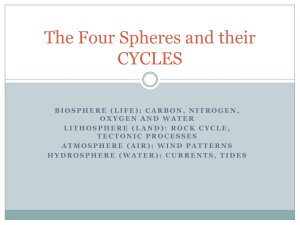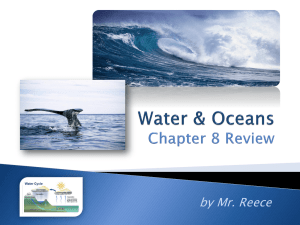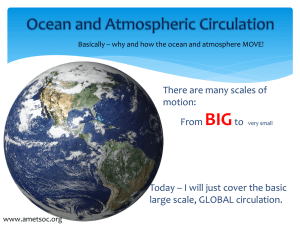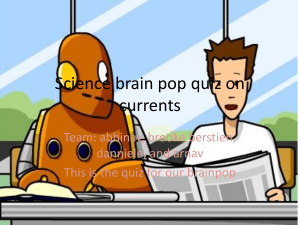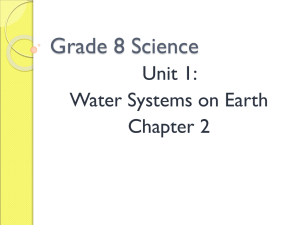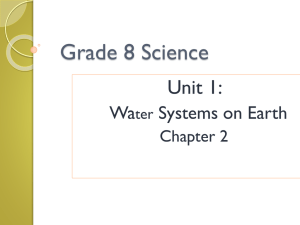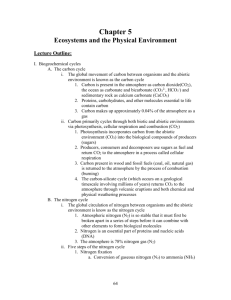File
advertisement
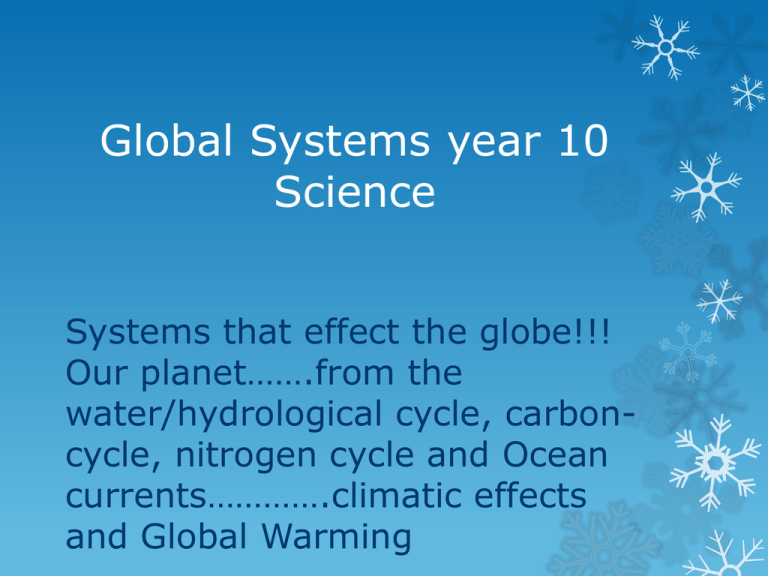
Global Systems year 10 Science Systems that effect the globe!!! Our planet…….from the water/hydrological cycle, carboncycle, nitrogen cycle and Ocean currents………….climatic effects and Global Warming OUTCOMES FOR THE TOPIC-students should know/be able to- Explain the natural cycling of matter- carbon, nitrogen and water cycle Influences over Earths Climate- ocean currents Sea, ICE, glaciers, fossils and sea level -> all evidence of climate change Effects climate change has on ecosystems and biodiversity Comparisons of cause and effect of “Greenhouse effect” Evidence that world climates have changed and will continue to do so The “MEASURABLE” Changes in the Earths atmosphere in the 20th/21st century are related to human activity Starting with the Water CycleHYDROLOGICAL CYCLE as we call it now we’re big people!!!!!!!!!!!!!!! Pre Quiz……what do you remember? 1. Draw what you think the water cycle looks like on a piece of paper ( students to do this in work book- teacher note- handout photocopy afterwards of the actual cycle to compare/keep 1. Include words on your diagram like, precipitation, condensation, evaporation , underground water, runoff…………..YOU HAVE 3 MINS…GO 2. What things do you already know/remember that influence climate? Click for answer Changes in ocean temperature Change in concentration of gases in atmosphere 3.What is the carbon cycle?- you should remember that carbon is an element found in all living things…..CLICK “carbon Cycle” describes the ways carbon changes form as it moves through the environment and atmosphere… NO NEED TO NOTE…WE LOOK IN DETAIL AT THIS CYCLE 4. What can you tell me about Global warming… click after some suggestions made Holes in ozone layer.. We have the “green house effect” This is a bit like a blanket being put on the earth trapping the warm air beneath….more heat in our immediate atmosphere- overall warmer global temperatures There is some evidence that global warming would have occurred…..as climates have changed through out the earth over time…..But has man hastened it??? 5. Tell me some of the Human influences you know effect the environment click … POLLUTION HABITAT DESTRUCTION ETC Vocabulary for this unit of work: please write as a list in your book and complete as we go over these words throughout the topic. • • • • • • • • • • • Atmosphere Biosphere Carbon cycle Denitrifying bacteria Fossil fuels Hydrosphere Leguminous plants Lithosphere Nitrogen cycle Nitrogen fixing bacteria Sustainable ecosystems The hydrological Cycle… Watch first part of Wild Weather DVD….. Click on “wet”. he explains the water cycle/weather…….stop at the end of his talk in his canoe as he goes under water. Then note the following important points: • Water is our most precious resource • The same water that was here in the beginning is still here today. • Constant recycling of water occurs from evaporation to condensation to precipitation…etc refer back to your water cycle diagrams • Evaporation occurs from the oceans, soil, plants and even animals • Largest amount of water vapour is from the ocean as it is the largest body of water • Are clouds vapour or liquid?????????? They are actually liquid . This important to note • Condensation is actually the opposite of evaporation • In Evaporation heat is needed to change the liquid water to vapour • In Condensation and cloud formation the vapour is attracted to dust particles in the air and then forms a less random structure than in vapour and the clouds are actually a liquid form of water we can see. They release heat as they form. They float as they are less dense than the air below them. Precipitation is really just the liquid in the clouds falling. Just a little about density………we said clouds float as they are less dense that air below them…..they can weigh tons….but their mass is spread over a large area and they are still less dense than the lower air. Density refers to the number of particles per unit volume LESS DENSE MORE DENSE DENSITY CONT: In the atmosphere as the air is heated……from the heat radiating from the earths surface…the particles will move farther apart and it becomes less dense and rises….. It then cools the higher it gets the particles move closer and it sinks…..the clouds are still less dense than the air and float on the slightly warmer more dense air Natural Influences on Climate (pg 183 Pearsons) Terms to Note: WEATHER- state of the atmosphere in relation to temperature, wind, cloud cover and precipitation Weather is created by interactions between the hydrosphere (all water on earth) and the Lithosphere( land masses) and the atmosphere (the layers of gas around the earth) WEATHER- changes day to day CLIMATE CLIMATE: The long term averages of weather conditions 30 years of weather records including extreme events are used to describe the climate of a particular place on our globe. Influences on climate include: • Sun is the ultimate source of energykeeps the planet warm enough to sustain life • Energy form sun is a major influence on climate • Earths Surface-it’s the features on the surface which determine the energy reflected back into space • Clouds and ice in the Artic and Antarctic reflect most of the energy (84 %) • Dark green forests in comparison -14% Gases in the Atmosphere: • Energy from sun- short wave radiation • Absorbed by clouds and earths surface- radiated back to space as long wave • EARTHS ATMOSPHERE- oxygen and nitrogen –have no effect on radiation coming in from sun or going out • However, other gases in the atmosphere though less have a greater effect on this radiation • Water vapour, carbon dioxide, methane, and nitrous oxide and ozone all allow short wave radiation through……but absorb the outgoing long wave radiation • They re-emit the heat in all directions….some being radiated back to earth • Its these gases that trap heat at the surface of the earth“ the green house effect” keeps the earth warmer • This re-radiated heat is long wave and can’t pass through glass hence the term “glass house or green house”…these work on that very principal- heat in (passes through the glass) trapped- keeps the greenhouse hotter great for plants and some vegies etc…..cant escape so constantly warmer than surrounding outside air. Orientation of the Earth • Earth basically spherical • Orbits the sun and rotates on its axis • The tilt and rotation causes the seasons ( give diagram or look at pg 185 Pearsons) • The rotation of Earth takes the atmosphere and waters with it • This movement influences our circulation and water-globally • However water circulation mainly influenced by temperature • Different temperatures of oceans around the world impact Australia’s climate now watch next bit Wild weather- currents and clouds….stop when gets to hurricanes etc Ocean Currents: spinning currents pg 185 • Continuous movements of ocean waters • Flow for great distances and cause water to circulate continuously around the earth • The circulation determines the climates • Currents occur at the surface and deep within the ocean • Causes of currents: • Wind • Temp • Variations in salinity • Rotation of earth on its axis • gravitational pull of sun and moon MAJOR SURFACE CURRENTS • Surface currents caused by wind • Pushes surface water along until it reaches land • Water then flows left/right or down • Major ocean basins-circular currents form-gyres • Flow clockwise in northern hemisphere and anticlockwise in southern hemisphere • Gyres patterns of circulation is caused by rotation of the earth (diag next slide) Deep Currents: • Begin at the poles- its very cold water here! • These deep currents flow through the ocean carrying the very cold water along the bottom • Surface and deep currents interact • Water cycles from deep currents to surface currents and back to the deep again- forms the THERMOHALINE CIRCULATION (conveyor) • Thermo-heat/temp, haline-salt, conveyertransportation • Very slow-1600 years to complete a full cycle • Distributes heat around the globe affecting climates Watch the animation link:- http://www.youtube.com/watch?v=3niR_Kv4SM The Gulf Stream: • Part of the global conveyor belt • The current which makes western Europe warmer in winter than anywhere else on the same latitude • I.E UK and Norway warmer than Green land and Canada • FLOWS FROM THE CARRIBEAN SEA TO THE NORTH ATLANTIC OCEAN • Feeds into the north Atlantic drift, Norwegian currents, into the Labrador and Greenland seas. • Artic winds then cool the water-increasing the density of the gulf stream • Denser water- sinks pushes away water below creates a deep current • This deep cold current flows all the way south to Antarctica Australia's Climate: • Australia –a land of contrast drought and floods can be experienced at the same time • These extremes the result of two phenomenon • Southern oscillation • Indian Ocean Dipole SOUTHERN OSCILLATION • sequence of changes that occur to the way the atmosphere and water circulate across the Pacific Ocean and Indonesian islands • Most years a cold current flows north to south America then west to equator- warmed by the sun= temp difference of 3-8 degrees Celsius between the cooler and the warmer western Pacific • Page 187 Pearson's. • Southern Oscillation index-measure of the atmospheric and ocean conditions across the Pacific Ocean-difference in air pressure between Tahiti and Darwin Continued… • • • • Normally this index is 0 During El Nino- very negative During La Nina- strongly positive EL NINO • best known extreme southern oscillation and most important influence on Australia’s Climate-particularly in QLD and NSW- little temp change , little air pressure change, trade winds weaken, cool air descends, little rainfall in this period Opposite occurs with La Nina-cooler, wetter, more wind- this event can last for over a year http://esminfo.prenhall.com/science/geoani mations/animations/26_NinoNina.html Indian Ocean Dipole: • Southern Australia influenced by the Dipolechange in temp of water between eastern and western areas of the Indian Ocean, near the equator • Not a regular change- does not happen every year or at the same time of year • Starts in MAY OR June-peaks in AugustDecember • Droughts are determined in Australia by the amount by which the temp of the sea differs and how long it lasts • http://www.youtube.com/watch?v=CTMuqSghR r8 Changing Climate: • Evidence is there to support the thought that Australia’s climate has been different in the past from what we experience today • Australia used to be joined to Gondwana- warmer and wetter climate • There has been cycles of warming and cooling • Tasmania/and southern covered with ice 2.5 million years ago (Glaciation) • 20, 000 ago current period of warming began • Ice Ages: ice caps expand at both poles –liquid water on earth decreases • Sea levels fall additional land exposed at the coasts Global Warming • Interglacials are periods between glaciationsGlobal Warming • Warming- means an increase in average world temperatures • Icecaps melt, sea levels rise, coastal lands flood • Evidence of rise and fall is seen in patterns of sediments and fossils in coastal rocks • Reasons for past global warming not really understood • Challenging to understand what contribution Humans are making to present period of global warming Evidence for Climate change… Glaciers:-advance when climates are cool/retreat when warm as glaciers grow they grind against rocks on the sides and floors of the valleys through which they flow- dragging rocks along with them This creates deep grooves or “scores” on the sides and when the glacier retreats they are clearly visible Leaves a pile of rocks- moraines Ice Cores • Sometimes snow falls on glaciers to form annual recognisable layers • Scientists take cores for places like Antarctica-analyse the physical and chemical properties of the ice –gaining information about temp & composition of the air from hundreds of thousands of years past- can show variations in sea level and amounts of C02 in the atmosphere over time frames 2010 • It was discovered that ice cores from the Antarctic showed a strong link between the amount of snow that falls in Eastern Antarctica and droughts in south western Australia • Eastern Antarctica over the last 30 years has had higher snow falls- while winter rains in SW Western Australia, has dropped by 15% • Reduce rainfall- climate changemodifying the path of the Antarctic circumpolar Current • Warm air to Antarctica-snowfall • Cool dry air Australia- reduced rainfall POLLEN ANALYSIS • Decays slowly • Often fossilized • Indicates the species growing when sediments were laid down • Changes in pollen types found-indicate changes in vegetation and climate SEA LEVEL CHANGE • World wide distribution of sedimentary rock and types of fossils are indicators of change in sea level • i.e sedimentary rock in central Australia has fossilised sea creatures Fossilized shells Do some review quest pg 191 Pearsons Back to the Carbon Cycle and Nitrogen Cycle • As said Carbon is essential for life • Found in all living things, their dead bodies and wastes • Found in the atmosphere as carbon dioxide • Used in photosynthesis • There IS NOT AN ENDLESS SUPPLY • Fossils are the preserved remains of once living organisms • Fossils fuels are made form the carbon of plants and animals that died millions of years ago- coal and oil • When burnt they release the coal and oil back into the atmosphere…so does burning wood , but this carbon has only been stored for hundreds to thousands of years • Earth’s largest store of carbon is in limestoneCalcium carbonate The Carbon Cycle- pg 178 Pearsons Nitrogen Cycle • Important cycle in Nature • Nitrogen is released into the soil as ammonia when an organism dies via bacteria • 2nd group- of bacteria get energy from ammonia and release nitrates back to soil • Plants take both nitrates and ammonia up through their roots • 3RD GROUP- nitrogen fixing bacteria absorb nitrogen trapped in soil in air pockets-convert to ammonia and nitrates • 4th group- Denitrifying bacteria-opposite to nitrogen fixing –get their energy form the nitrates and convert back to gaseous nitrogenreleased back into atmosphere. Nitrogen cycle- pg 179 Pearsons

